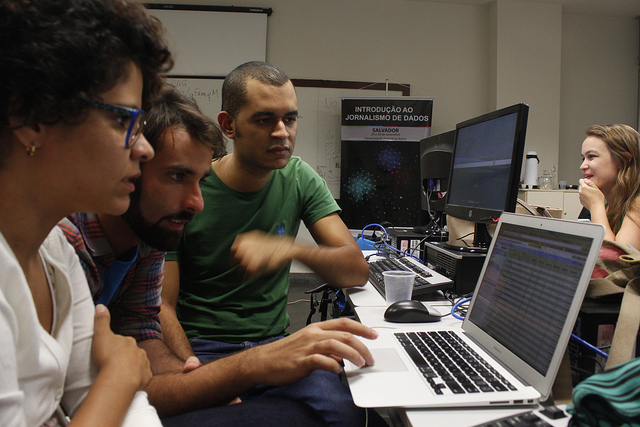Brazilian journalists immerse themselves in the world of data
A selected groups of Journalists, students of public universities and media professionals in Brazil started a no-return journey into the world of data. Escola de Dados — that’s how we call School of Data in the biggest country in Latin America — has partnered up with Universidade Federal da Bahia (UFBA), Universidade Federal do Rio de Janeiro (UFRJ), and Universidade de São Paulo (USP), three major Brazilian public universities, to offer a 30 hours, 5 days, hands-on and super intensive, Introduction to Data Journalism course.
The 100% free and on site training sessions happened in the November and December 2014 and in April 2015. They were possible thanks to the Partnership for Open Data, a program to stimulate open data initiatives in developing countries, funded by The World Bank and coordinated by Open Knowledge and Open Data Institute.
In total, 90 students, independent journalists and professionals from major media outlets from 12 different cities in Brazil were brought together by a tough selection process. More than 500 candidates from all over the country applied to Escola de Dados’ data journalism course.

What is this thing called data journalism?
In the first day students discussed what data journalism is all about. From building multidisciplinary teams to borrowing skills from other areas (and discussing the business case for data journalism, of course), the lesson showcased many stories and media outlets in the world that are pushing the boundaries of journalism, investigative reporting, data analysis, data visualization and storytelling in new platforms and formats. Students reported on their core skills and their expectations for the course and formed teams to work on data stories during the week.
Here are the resources used in the first day:
Slides – Introduction to Data Journalism
Online & Offline: Where do I find (open) data? Should I clean it? How?
The second day was all about means to get data, online or offline and, once in our hands, how to clean it if needed. Students learned how to tap the powerful features of search engines to find hidden documents, narrow down searches and explore the deep web. They also talked about Brazil’s Freedom of Information Law, which allows anyone to request government data in an open format. In the last part students learned how to use Open Refine, an open source tool with wonderful tools to clean messy data.
Here are the resources used in second day:
Finding stories in data: asking the right questions in a different type of interview
In the third day students were invited to deepdive in the world of data analysis using a spreadsheet tool, like Open Office’s Calc or Google Sheets. The six-hour session showed the groups how stories can be dug out of datasets and what questions can be asked. Students were introduced to great functions that help journalists understand statistics and data analysis in a friendly way, like the famous “vlookup” which allows two tables with a common column to be joined for further analysis. Steve Doig, renowned data journalist and trainer from the United States, gently provided his “Datamania” table to be part of Escola de Dado’s course.
Here are the resources used in the third day:
Slides – Finding stories in data
Not magic: Scraping data from the web & data visualization
Scraping the web and ways to visualize data were the subjects of the fourth day. In the first part, students learned how to use an array of tools to scrape data from web pages, without the need to write a single line of code. They learned how a web page works inside-out using the webinspector tool present in all modern browsers and saw how tools like Google Sheets, IFTTT and Chrome’s Web Scraper extension can help journalist to extract information from web pages in an automated fashion. The second part of the class was dedicated to introduce concepts of data visualization and design. Students walked through many good and not so great examples of data visualization. They also got to know amazing free tools to visualize data, such as Infogr.am, Timeline.js, Odissey.js, Tableau Public and Datawrapper.
Here are the resources used in the fourth day:
Slides – How web pages are structured
The power of Geojournalism and how maps can make you a better journalist
The last day introduced students to Geojournalism, which is basically the use of maps and geolocalised data to find relevant stories. Groups learned how to use jeo, a WordPress theme for interactive maps and journalism and cartoDB, a great tool to visualize data on maps on the web without a hassle. In the last part groups presented their data journalism projects, which included a profile of elected representatives in Rio de Janeiro, an analysis of the water shortage that affects São Paulo and a violence map of micro regions in Salvador.
We were fortunate to meet extremely talented photography and journalism students who volunteered themselves to cover the courses with blog posts and pictures throughout the two weeks in both Salvador and Rio de Janeiro. Our reporters collected testimonials from the students and wrote about the overall atmosphere of the sessions, keeping the Portuguese-speaking School of Data community up to date with our activities. We also used social media, such as twitter and Facebook to spread the word about the courses as we went. You can check out our coverage (Brazilian-Portuguese only!) in the links and photo gallery below.
These courses are part of Escola de Dados broad strategy to foster data literacy in Brazil, with a focus on the journalism community. The experience showed us that there is a demand for data journalism in educational institutions in the country. Escola de Dados will keep pursuing partnerships that strengthen the connection between the academia, students and professionals so that they can build together the platform they need to prepare the next generation of journalists and of journalism itself in Brazil.

